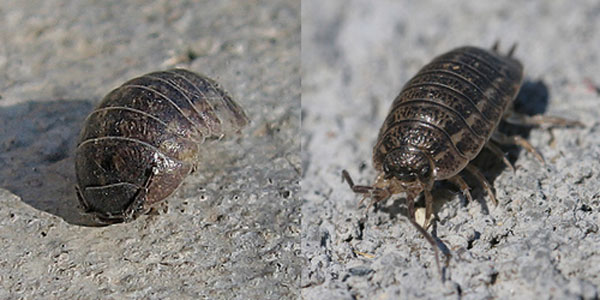Sowbug or Pillbug? It’s Just a Chucky Pig!
By Chris Williams on May 4, 2013.

Question
What’s the difference between a sowbug and a pillbug? We have one or the other in our basement almost every spring.
Answer
Sowbugs and pillbugs are kissing-cousins that look almost identical. Despite the names, they’re not bugs, they’re crustaceans, more closely related to shrimp and crayfish. Since they both have the same habits, there’s not much need to tell them apart except for scientific curiosity. They are both grayish-brown, about 3/8 inch long, with seven pairs of legs, and with overlapping “plates” on their backs. Some say they look like very short millipedes. The main difference is that pillbugs can roll themselves up into a protective ball when threatened, like an armadillo; sowbugs cannot. Sowbugs have a pair of short tail-like structures on the end of their bodies; pillbugs do not.
What’s in a Name!
I’m always intrigued by the various regional names that we have for the same insect pests. Both of these crustaceans sometimes come under the heading of woodlice, although they’re not related to lice at all. Kids love to make the harmless pillbugs roll into a ball, so they also go by the name rollie-pollie, or roly-poly…your choice of spelling. In the U.S., we seem pretty much content with the names sowbug and pillbug, but in Britain they are much more creative.
Here are just some of the regional names for sowbugs and pillbugs in various parts of Britain: armadillo bug, boat-builder, cheeselog or cheesy bug, doodlebug, potato bug, roll-up bug, chuggypig or chucky pig, gramersow, butcher boy or butchy boy, wood bug, carpenter, and slater. While some of these names make some sense, I would love to know the origin of the others.
Sowbugs and pillbugs are outdoor arthropods found in damp sites around foundations, hiding in mulch, under leaves, stones, splash blocks, flower pots, in grass clippings, compost, or under bark. They feed on decaying plant materials. They move into homes when their outdoor conditions become too wet or too dry. Inside, they’re found around door thresholds or in damp areas like basements and laundry rooms. Neither sowbugs nor pillbugs bite, and they don’t do any damage indoors. They die pretty quickly in the drier indoor environment.
To cut down on these indoor visitors, you can take steps to reduce their numbers around your outside foundation. Remove excessive leaves, mulch, or grass clippings. Firewood, boards, and stones should be stacked up off the ground and away from building foundations. Also, close gaps around doors and windows where they are entering by installing thresholds or door sweeps, tightening screens, and caulking openings.
Photo credit: sankax / Foter.com / CC BY-NC
Photo credit: Maggie Osterberg / Foter.com / CC BY-NC-SA